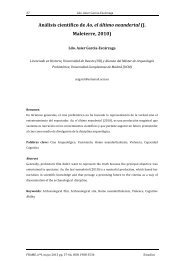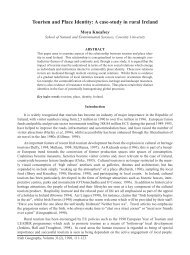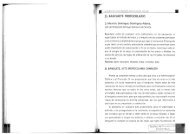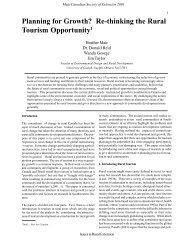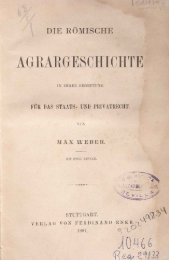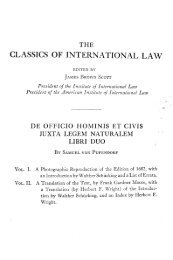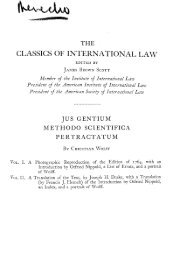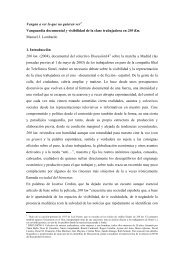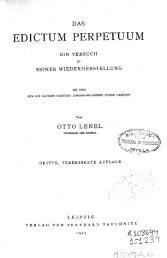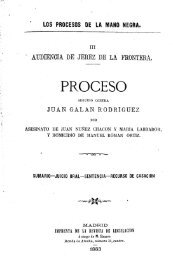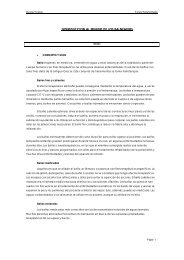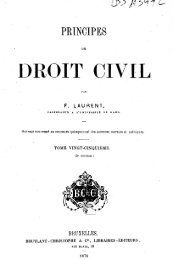Measuring Sustainable Tourism Development in Remote Rural ...
Measuring Sustainable Tourism Development in Remote Rural ...
Measuring Sustainable Tourism Development in Remote Rural ...
Create successful ePaper yourself
Turn your PDF publications into a flip-book with our unique Google optimized e-Paper software.
Introduction<br />
<strong>Tourism</strong> is seen as a possible and viable strategy for development <strong>in</strong> many remote<br />
rural areas, be<strong>in</strong>g viewed as perhaps best meet<strong>in</strong>g the requirements of environmental<br />
susta<strong>in</strong>ability, employment, public and private <strong>in</strong>vestment, <strong>in</strong>frastructure betterment and<br />
economic benefits. The development of tourist facilities and recreational opportunities<br />
has frequently been viewed as a means of redress<strong>in</strong>g regional disparities <strong>in</strong> <strong>in</strong>comes<br />
and employment (Mathieson and Wall, 1982). Tourists can play an important part of<br />
community development by giv<strong>in</strong>g local residents the possibility of earn<strong>in</strong>g some<br />
additional <strong>in</strong>come. It is argued that s<strong>in</strong>ce local materials and labour are employed <strong>in</strong><br />
local production, it represents potential for small-scale development of susta<strong>in</strong>able<br />
tourism.<br />
The economy of remote rural areas has traditionally been dependent upon a s<strong>in</strong>gle<br />
local <strong>in</strong>dustry, either agriculture, fisheries or other (but mostly agriculture). Thus<br />
agriculture will, <strong>in</strong>evitably, have an <strong>in</strong>fluence on local tourism development, s<strong>in</strong>ce it is<br />
still part of the local people’s daily lives. Cox and Fox (1991) illustrated the important<br />
relationship between agriculture and tourism, recognis<strong>in</strong>g the need to exam<strong>in</strong>e this<br />
further, to ensure that the potential of agriculturally based leisure attractions could be<br />
realised. “Agriculture is traditionally the economic ma<strong>in</strong>stay of rural areas, there is a<br />
l<strong>in</strong>kage between agriculture and tourism”.<br />
The current global tourism market is experienc<strong>in</strong>g changes <strong>in</strong> tourism demand and<br />
consumption patterns as perhaps never before. The tourism consumer is chang<strong>in</strong>g<br />
through greater awareness of the world, wider experiences and tourism products, both<br />
domestically and <strong>in</strong>ternationally, and through chang<strong>in</strong>g consumer pressures and<br />
expectations. The current affects of change are lead<strong>in</strong>g to the rise <strong>in</strong> the<br />
“unmanageable” consumer, the consumer who is more knowledgeable with a wider<br />
perspective of tourism and its products and therefore <strong>in</strong>creas<strong>in</strong>gly demand<strong>in</strong>g (Jones,<br />
1997). This may imply that <strong>in</strong>ternational mass tourism is no longer a homogenous<br />
phenomenon it purportedly used to be.<br />
Chang<strong>in</strong>g perceptions are lead<strong>in</strong>g to higher expectations or desired services by<br />
consumers <strong>in</strong> tourist areas. However, not only is it desirable to study the nature of<br />
tourist demand and the character of the accompany<strong>in</strong>g movements of people, for the<br />
purpose of understand<strong>in</strong>g the driv<strong>in</strong>g forces beh<strong>in</strong>d recent growth <strong>in</strong> tourism: it is also<br />
desirable to know someth<strong>in</strong>g about the impact (environmental, economic, cultural etc.)<br />
of the tourists on the areas which they visit. The need for studies <strong>in</strong> this field has<br />
grown with the realisation that tourist developments do not always br<strong>in</strong>g benefit to the<br />
host areas; <strong>in</strong>deed they may lead to the accentuation of the exist<strong>in</strong>g social and<br />
economic problems or to the creation of new problems altogether (White, 1974: 1-2)<br />
Literature Review<br />
The susta<strong>in</strong>able approach to development is not new and there have been many<br />
<strong>in</strong>terpretations of what susta<strong>in</strong>able development is. But it is now generally accepted<br />
that susta<strong>in</strong>able development recognises the validity of three <strong>in</strong>terests - the<br />
environment (natural and man made), the economy and socio-cultural concerns<br />
(Macgillivray & Zadek, 1995). Writers generally trace the orig<strong>in</strong>s of the term<br />
"susta<strong>in</strong>able development" back to a 1987 World Commission on Environment and<br />
<strong>Development</strong> report entitled "Our Common Future", also known as the Brundtland



